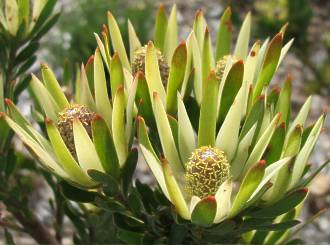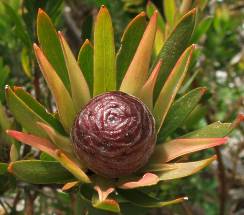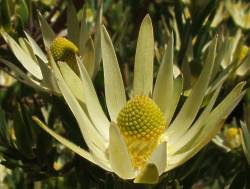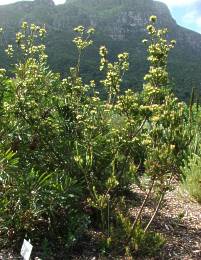Leucadendron loeriense
Leucadendron loeriense I.Williams
Family: Proteaceae
Common names: loerie conebush (Eng.); loerietolbos (Afr.)
SA Tree No: 80.7
Introduction
Leucadendron loeriense is one of the few members of the protea family that flower in mid-summer, producing its lovely star-shaped flowerheads and red-tinged cones in time to decorate the Christmas table.

Description
Description
Leucadendron loeriense is a slender, upright shrub 2-3 m tall, branching from a single stem. Leaves are dark green often flushed with red, 20-35 mm long and 3-6 mm wide, narrowly oblong with a sharply pointed tip, and are covered in velvety hairs. The involucral leaves form a decorative, star-like cup and are produced in mid-summer (December-January). Up to 16 involucral leaves are crowded at the tips of the stems, each one lance-shaped and yellowish to greenish white, and hairless on the inner surface. The male flowerhead is cone-shaped, 15 mm long and 12 mm wide and yellow. The female flowerhead is egg-shaped, 13 mm long and 10 mm wide.

Insome plants, the involucral leaves of the female do not change colour. The cone is greenish with yellow flowers, and as the cone ages it becomes tinged with red, often ending off completely red. Mature cones are 25 mm long and 20 mm in diameter. Seeds are small, 6 mm long, black, triangular, with a broad wing. They take several months to ripen, and are retained in the cones on the plant for several years.

Leucadendron loeriense is very similar to L. uliginosum subsp. uliginosum, the Outeniqua conebush and L. uliginosum subsp. glabratum, the Tsitsikamma conebush. L. loeriense cones are reddish or yellow, whereas those of L. uliginosum are silvery. And, looking at the leaves, the hairs on L. loeriense leaves are erect, whereas on L. uliginosum subsp. uliginosum the hairs lie flat against the leaf surface, and in the subsp. glabrata they are hairless when mature. Also, L. uliginosum subsp. uliginosum has an overall silvery appearance whereas L. loeriense does not.

Conservation Status
Status
Least Concern (LC). Leucadendron loeriense is not threatened with extinction in the wild in the near future. It was thought to be rare, known only from a few populations at widely separated localities, but more populations have been found and many of the populations have more than 10 000 plants. Although its type locality has been decimated by pine plantations, these are being phased out. Most of the populations occur in natural, alien-free veld and face insignificant threats. Populations in the eastern part of its distribution range are at risk from too-frequent fires.
Distribution and habitat
Distribution description
Leucadendron loeriense occurs in the Eastern Cape, on the Elandsberg, Baviaanskloof and Winterhoek Mountains. It grows in dense stands in widely separated localities on sandstone slopes, between 450 and 1200 m above sea level. Climate in this region is warm temperate, and rainfall occurs throughout the year.
Derivation of name and historical aspects
History
Leucadendron loeriense is relatively new to science, having only been described by Ion Williams in 1967. It gets its species epithet from its type locality, the Loerie Forest Reserve, situated between Van Stadens, Baviaanskloof and the Groot Winterhoek Mountains in the Humansdorp District. Loerie is a small town in the foothills of the Elands and Groot Winterhoek Mountains. It is named after the Loerie River, which is named after the Knysna Loerie, which inhabits the forest along the river banks.
The name Leucadendron is derived from the Greek leukos meaning white, and dendron, tree. This genus is named after and based on Leucadendron argenteum, the silver tree, from its common name witteboom, meaning white tree, as it was known in the 1690s when the genus was first named.
The genus Leucadendron belongs in the protea family. It consists of 83 species, most of which occur in the Western and Eastern Cape with a few outliers in KwaZulu-Natal. They are all dioecious (flowers unisexual; female and male flowers on separate shrubs or trees), and are known as conebushes because the female flower heads form woody cones in which the fruits are borne.
Ecology
Ecology
Leucadendron loeriense is killed by fire; seeds are stored in cones on the plant and are released after the fire and dispersed by wind. Flowers are pollinated by insects.
Uses
Use
Leucadendron loeriense is a decorative garden shrub and it provides a range of material for the vase: the flower heads and the fresh female cones are long-lasting and decorative, and the dried cones are also decorative. Flowering and fruiting over the Christmas season, the starry flower heads and red bauble-like cones make lovely alternative Christmas decorations.

Growing Leucadendron loeriense
Grow
Leucadendron loeriense requires a sunny situation with free air circulation and well-drained, acidic soil. It tolerates drought but performs best with moderate water all year round. This species is quite slender and lanky and occurs in dense stands in nature. Planting in groups of three to several plants close together (300-500 mm apart) mimics their natural habitat and makes for a more dense and floriferous garden specimen. This species can be planted in the fynbos garden, the Mediterranean garden or the ordinary suburban garden, provided the soil is not soggy, and it is not too humid.
Leucadendron loeriense can be propagated by seed or cuttings. Sow seed in autumn in sterile, well-drained soil. Cover them with clean sand or fine-milled bark and keep moist but not wet. Germination occurs after about 30 days, but it can be erratic. Treating the seed with Instant Smoke Plus Seed Primer will enhance germination. Transplant the seedlings into individual bags or pots when the first true leaves have developed. Use a well-drained, acidic soil mix. Grow on for a year before planting out into the garden.
Take semi-hardwood cuttings from the current season's growth in autumn or spring. Remove the leaves from the basal third of the cutting, treat with rooting hormone and place in well-drained rooting medium under intermittent mist with bottom heat of 24°C. Rooting takes about 6 weeks; harden off for 3 weeks and transplant into individual containers filled with well-drained, acidic soil.
References
- Leistner, O.A. (ed.). 2000. Seed plants of southern Africa: families and genera. Strelitzia 10. National Botanical Institute, Pretoria.
- National Red List of South African Plants 03-02-2009, available from www.sanbi.org or redlist@sanbi.org.
- Olivier, Willie & Olivier, Sandra, 2005. Touring in South Africa: the great South African road trip guide. Struik Publishers, Cape Town.
- Plants of southern Africa : an online checklist. http://posa.sanbi.org
- Protea Atlas Project. http://protea.worldonline.co.za.
- Rebelo, Tony. 2001. Proteas, A field guide to the proteas of Southern Africa, edn 2.. Fernwood Press & National Botanical Institute, Cape Town.
- Rebelo, Tony et al. manuscript version Dec. 2006. African Proteaceae Red Data List. to be submitted to Strelitzia
- Vogts, Marie. 1982. South Africa's Proteaceae, Know them and grow them. Struik Publishers, Cape Town.
- Williams, I.J.M. 1972. A revision of thegenus Leucadendron (Proteaceae).Contributions from the Bolus Herbarium No. 3. The Bolus Herbarium, University of Cape Town.
Credits
Alice Notten
Kirstenbosch National Botanical Garden
December 2009
Plant Attributes:
Plant Type: Shrub
SA Distribution: Eastern Cape
Soil type: Sandy
Flowering season: Early Summer
PH: Acid
Flower colour: Yellow
Aspect: Full Sun
Gardening skill: Average
Special Features:
Horticultural zones











Rate this article
Article well written and informative
Rate this plant
Is this an interesting plant?
Login to add your Comment
Back to topNot registered yet? Click here to register.